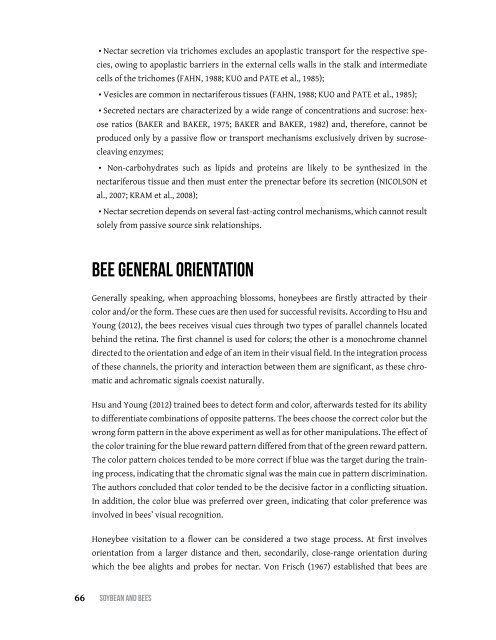SOYBEAN and BEES
BFhV4z
BFhV4z
Create successful ePaper yourself
Turn your PDF publications into a flip-book with our unique Google optimized e-Paper software.
• Nectar secretion via trichomes excludes an apoplastic transport for the respective species,<br />
owing to apoplastic barriers in the external cells walls in the stalk <strong>and</strong> intermediate<br />
cells of the trichomes (Fahn, 1988; Kuo <strong>and</strong> Pate et al., 1985);<br />
• Vesicles are common in nectariferous tissues (Fahn, 1988; Kuo <strong>and</strong> Pate et al., 1985);<br />
• Secreted nectars are characterized by a wide range of concentrations <strong>and</strong> sucrose: hexose<br />
ratios (Baker <strong>and</strong> Baker, 1975; Baker <strong>and</strong> Baker, 1982) <strong>and</strong>, therefore, cannot be<br />
produced only by a passive flow or transport mechanisms exclusively driven by sucrosecleaving<br />
enzymes;<br />
• Non-carbohydrates such as lipids <strong>and</strong> proteins are likely to be synthesized in the<br />
nectariferous tissue <strong>and</strong> then must enter the prenectar before its secretion (Nicolson et<br />
al., 2007; Kram et al., 2008);<br />
• Nectar secretion depends on several fast-acting control mechanisms, which cannot result<br />
solely from passive source sink relationships.<br />
Bee general orientation<br />
Generally speaking, when approaching blossoms, honeybees are firstly attracted by their<br />
color <strong>and</strong>/or the form. These cues are then used for successful revisits. According to Hsu <strong>and</strong><br />
Young (2012), the bees receives visual cues through two types of parallel channels located<br />
behind the retina. The first channel is used for colors; the other is a monochrome channel<br />
directed to the orientation <strong>and</strong> edge of an item in their visual field. In the integration process<br />
of these channels, the priority <strong>and</strong> interaction between them are significant, as these chromatic<br />
<strong>and</strong> achromatic signals coexist naturally.<br />
Hsu <strong>and</strong> Young (2012) trained bees to detect form <strong>and</strong> color, afterwards tested for its ability<br />
to differentiate combinations of opposite patterns. The bees choose the correct color but the<br />
wrong form pattern in the above experiment as well as for other manipulations. The effect of<br />
the color training for the blue reward pattern differed from that of the green reward pattern.<br />
The color pattern choices tended to be more correct if blue was the target during the training<br />
process, indicating that the chromatic signal was the main cue in pattern discrimination.<br />
The authors concluded that color tended to be the decisive factor in a conflicting situation.<br />
In addition, the color blue was preferred over green, indicating that color preference was<br />
involved in bees’ visual recognition.<br />
Honeybee visitation to a flower can be considered a two stage process. At first involves<br />
orientation from a larger distance <strong>and</strong> then, secondarily, close-range orientation during<br />
which the bee alights <strong>and</strong> probes for nectar. Von Frisch (1967) established that bees are<br />
66 SoybeAn <strong>and</strong> bees






